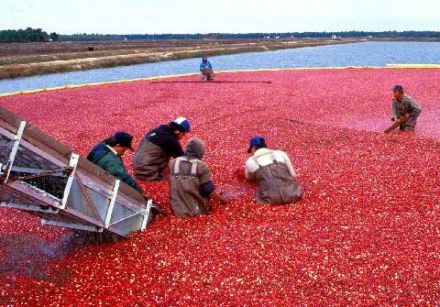 |
All about Cranberry - Cultivation
The shrub has stiff branches and many roots and in its natural state grows in the poor acidic soil of shore regions and peat bogs. It can live for over 100 years: it is said that some plants in the Cape Cod region of Maine are over 150 years old.
Berries
Its sour berries grow on upright shoots stemming from the creeping branches. They are between 10 and 20 mm in diameter and look like small cherries: little red lights on a green background that provide Christmas colors beginning in late July. But there are also white cranberries. The white flesh has little juice and contains many white seeds.
Harvest
When the berries are grown in bogs, the harvest of a large area is carried out by flooding. "Egg beaters" - tractors equipped with balloon tires and a churning attachment - pass through the bushes and detach the cranberries from the branches. Then the floating berries are collected. This process takes place once a year, after the first frost but before the first snowfall, once the bushes reach the age of three.
In Quebec, the cranberry harvest takes place between the end of September and the end of November. When mature, the fruit is a nice red colour and between 10 and 20 mm in diameter. These days, the harvest is mechanized. Between 15 and 20 cm of water is pumped into the pond-shaped parcel of land. The plants are beaten to detach the fruit from the shrubs and then the water level is raised to 35 or 40 cm. The air-filled berries float to the surface and are then easily moved to one end of the pool by surrounding them with booms. They are then pumped into trucks to be transported to the sorting and cleaning station.
Cranberries favour mountainous regions, coniferous forests, bogs and marshes. They have found perfect growing conditions in North America, central Europe and the tundra of Scandinavia.


-

 Recipes
Recipes
-

 Products
Products
-

 Entertaining
Entertaining
-

 Chefs
Chefs
-

 Hints & Tips
Hints & Tips
-

 Glossaries
Glossaries








